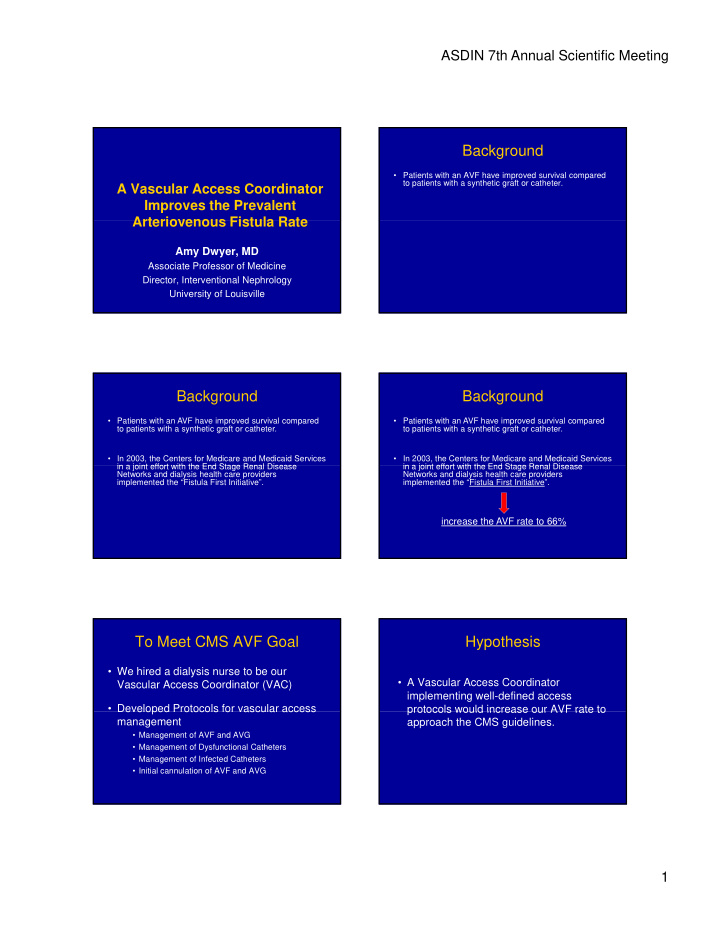



ASDIN 7th Annual Scientific Meeting Background • Patients with an AVF have improved survival compared to patients with a synthetic graft or catheter. A Vascular Access Coordinator Improves the Prevalent Arteriovenous Fistula Rate Arteriovenous Fistula Rate Amy Dwyer, MD Associate Professor of Medicine Director, Interventional Nephrology University of Louisville Background Background • Patients with an AVF have improved survival compared • Patients with an AVF have improved survival compared to patients with a synthetic graft or catheter. to patients with a synthetic graft or catheter. • In 2003, the Centers for Medicare and Medicaid Services • In 2003, the Centers for Medicare and Medicaid Services in a joint effort with the End Stage Renal Disease in a joint effort with the End Stage Renal Disease in a joint effort with the End Stage Renal Disease in a joint effort with the End Stage Renal Disease Networks and dialysis health care providers Networks and dialysis health care providers implemented the “Fistula First Initiative”. implemented the “Fistula First Initiative”. increase the AVF rate to 66% To Meet CMS AVF Goal Hypothesis • We hired a dialysis nurse to be our • A Vascular Access Coordinator Vascular Access Coordinator (VAC) implementing well-defined access • Developed Protocols for vascular access Developed Protocols for vascular access protocols would increase our AVF rate to protocols would increase our AVF rate to management approach the CMS guidelines. • Management of AVF and AVG • Management of Dysfunctional Catheters • Management of Infected Catheters • Initial cannulation of AVF and AVG 1
ASDIN 7th Annual Scientific Meeting Vascular Access Coordinator Responsibilities Important Characteristics of VAC • Serve as patient liaison between the Interventional Nephrology Center and dialysis facilities, nephrologists, nurse practitioners and surgeons on all vascular access related issues • Monthly vascular access evaluation with physical exam • Monthly review of previous 12 dialysis treatment data including: Delivered dose, Kt/V Ability to achieve prescribed blood flow Venous Pressures • Hemodialysis experience Arterial Pressures • Report physical exam and dialysis treatment abnormalities to Nephrologist, NP • Refer patients for vascular access evaluation based on findings • Excellent organizational skills • Schedule vascular access procedures (angiography, vein mapping, surgery) • Schedule outpatient dialysis treatments around vascular access procedures • Review patient allergies and provide Rx for sensitivities to IV contrast • Capable of functioning independently C bl f f ti i i d d tl • Review patient history and provide pre-medication Rx for procedures in CKD patients • Obtain medical records and forward to Interventional Nephrology Center • Schedule appointments with surgeons for pre-access evaluation • Outstanding communication skills • Coordinate with surgeons office for access placement surgery • Schedule post-op access placement appointments • Remove sutures from access procedures • Evaluate difficult cannulations and all new accesses • Provide recommendations to dialysis staff about access needle size • Educate patients and staff about vascular access care and maintenance • Document all vascular access appointments in electronic database • Maintain accurate records of all dialysis access events • Track Monthly Access Related Infections • Participate in vascular access data collection • Provide Renal Network with monthly reports and data required • Attend Network required in-services and education • Work with Director of Interventional Nephrology to develop Policies & Procedures Methods Statistical Analysis • Retrospective review of monthly Renal 1. The effect of a Vascular Access Network Vascular Access Tracking Coordinator on the rate of change in Reports from Jan 2008 to Dec 2010 fistula and catheter rate was determined by regression of the rate of change by regression of the rate of change during the 12 months prior to hiring • Prevalent access type compared to the 12 months after hiring • Prevalent Catheter rates and implementation of vascular access • Type of access at HD initiation protocols. Results Statistical Analysis University of Louisville Vascular Access 2. Comparison of vascular access type for 70 p< 0.001 new patients was performed by chi- 60 tients (%) square analysis. 50 AVF 40 40 Percent of Pat GRAFT CATHETER 30 CMS GOAL 20 10 0 Jan-08 Apr-08 Jul-08 Oct-08 Jan-09 Apr-09 Jul-09 Oct-09 Jan-10 Apr-10 Jul-10 Oct-10 Jan-11 2
ASDIN 7th Annual Scientific Meeting Results Results Access Type at Dialysis Initiation for New patients University of Louisville Catheters 30 16 tients (%) 14 Cath Only < 90 Days 25 12 tients Cath Only > 90 Days 10 20 (p (p=0.000018) ) Percent of Pat Number of Pat AVF Cath with AVF Maturing 8 15 Catheter 6 Cath with Graft Maturing Cath + AVF 4 10 CMS Goal 2 5 0 8 8 8 9 9 9 0 0 0 1 0 0 0 0 0 0 1 1 1 1 0 - - - - - - - - - - n y p n y p n y p n a e a e a e a a a a M S M S M S J J J J 2008 2009 2010 Conclusions Conclusions 1. A VAC with defined responsibilities and 2. Despite high incident catheter rates, the implementing detailed vascular access prevalent catheter rate (catheter > 90 protocols protocols days) can be decreased and prevalent days) can be decreased and prevalent AVF rate increased. • Can improve the prevalent fistula rate • Decrease catheter rate Future Directions Acknowledgement • Paula Shelton, RN • We are developing a similar protocol driven approach that provides the same level of commitment in non-dialysis stage level of commitment in non dialysis stage • Michael Brier PhD • Michael Brier, PhD 4 CKD patients • George Aronoff, MD 3
Recommend
More recommend